You can easily go without tomato cages in your garden. In fact, tomato cages aren’t necessary at all and here is what I use as my tomato cage alternative in my garden.

You do not need tomato cages. This is not a popular opinion, but it is true. Tomato cages are one of the most challenging things in the garden, and I set out a few years ago to learn new ways to support and encourage my tomatoes’ growth through the seasons without the use of a tomato cage.
Not only will you spend between $5-10 or more if you head this route on tomato cages, but you will be left with a way to store them! I promise there are other alternatives to how you approach the tomato cage or, in my case, ditch them altogether.
After my own frustration that with every single storm in late August, my tomatoes were flopping over all over the tomato companion plants no matter what I did and adding more and more supports, I decided if I was going to grow tomatoes, I needed to figure out a different method.
Why You Need to Support Tomatoes:
Tomatoes need to grow upward. Though they can grow on the ground and actually will create root systems to do this, they are less likely to accrue disease and have issues if you grow them vertically. It also frees up plenty of space in your garden.
The other reason is that many of the most harmful pests to tomatoes will come straight out of the garden (hello, Hornworm), so by growing them vertically and pruning tomatoes regularly, and then placing tomato companion plants with them, you will be in for a literal treat of a great tomato harvest. Supporting them isn’t just an option. It is a necessity, in fact.
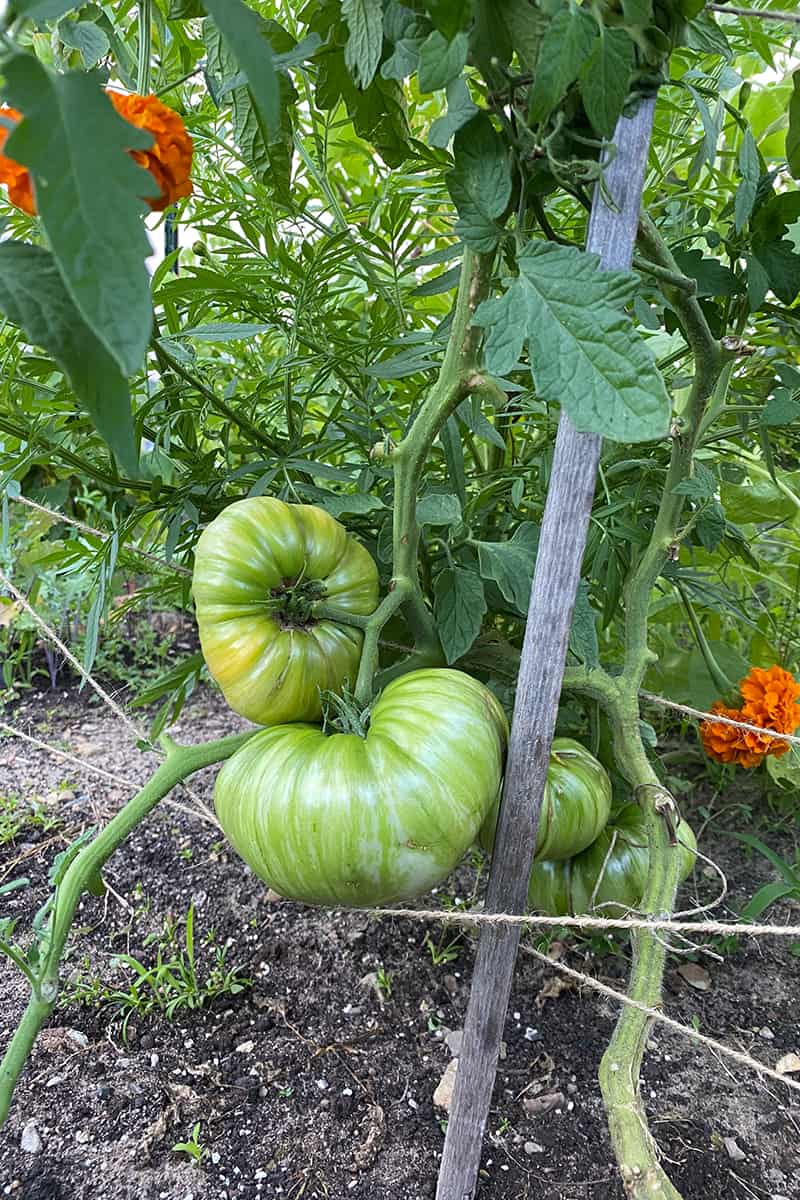
Why Tomato Cages Aren’t Necessary:
Tomato cages are really challenging to work with. There I said it! They will be flopping over and in need of support by the time your plant is ready for harvesting. I have tried many cages and wasted a ton of money, only to be disappointed when a big wind comes along.
Sure, there are great DIY options out there, like this tomato cage alternative, which may work as well, but ultimately I find that none of them have worked as well as the method I note below. Not to mention there is the challenge of storing tomato cages. You can skip all of that, and if you are wanting to be resourceful, even compost some of the materials when you are done.
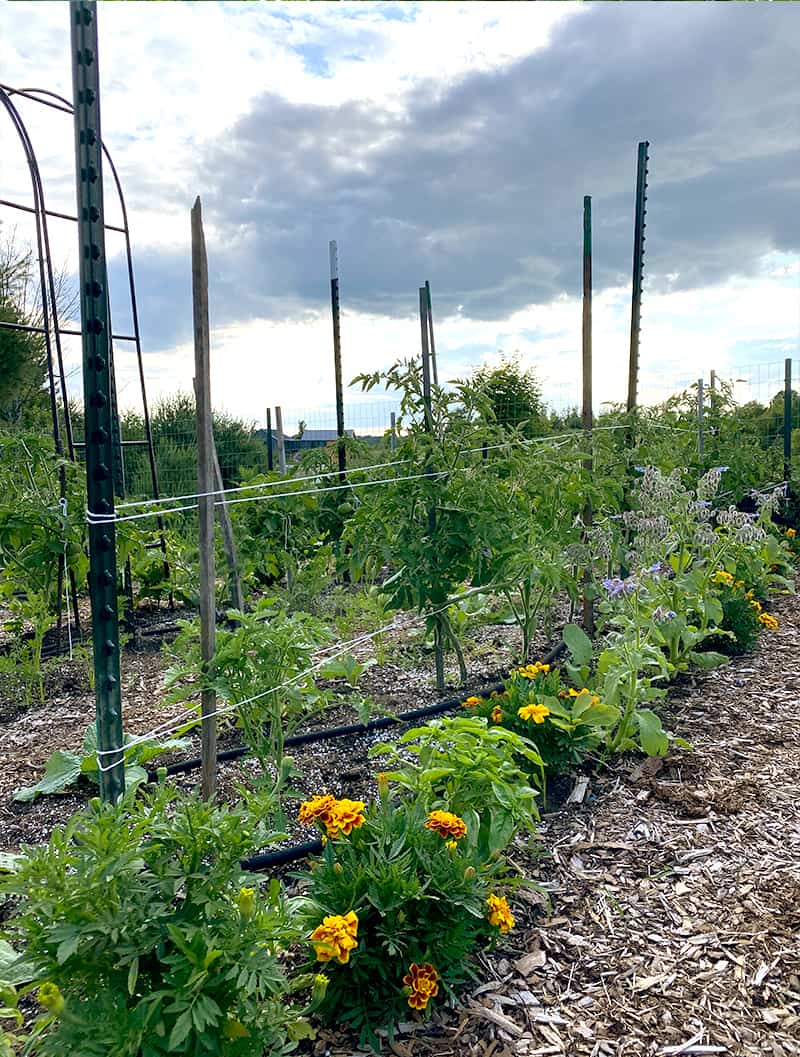
Benefits Of Not Using Tomato Cages
Less maintenance required
Tomato cages provide the necessary structure to keep your tomato plants upright, but they come with added maintenance. Without cages, you don’t have to worry about staking and pruning the vines so they fit into the framework of the cage.
More natural growth patterns for tomatoes
Tomato plants can grow in a more natural and unrestricted way when not confined to the shape of a tomato cage. This allows for better air circulation between plants, which helps with disease prevention.
More space-efficient growing options
Cages take up a lot of space in the garden and can be difficult to maneuver around. Without cages, you have more room to work with, making it easier to fit multiple plants in one area. Furthermore, you don’t need to worry about rearranging or reconfiguring your cages as your plants grow.
Potential for increased yield
With more space and freedom to grow, tomatoes can reach their full potential and produce a greater yield. When grown in cages, the framework restricts the plants’ growth and makes it harder for them to develop their fruits fully.
My Easy Method For Supporting Tomatoes:
I use a very simple and low-material method to support and grow my tomatoes vertically. With this method, along with regular pruning, my tomatoes aren’t just supported but incredibly productive and easy to harvest. They require minimal maintenance through the growing season besides just some occasional pruning to encourage light and airflow as the plant expands. This method works for both determinate and indeterminate tomatoes. Here is what I do:
- Plan Ahead: This is the main thing. For this method, you will want to place your tomatoes in a row of some kind. Below you will find an example raised bed design for this method with companion plantings. Placing the plants in a row creates the option for this system to work best.
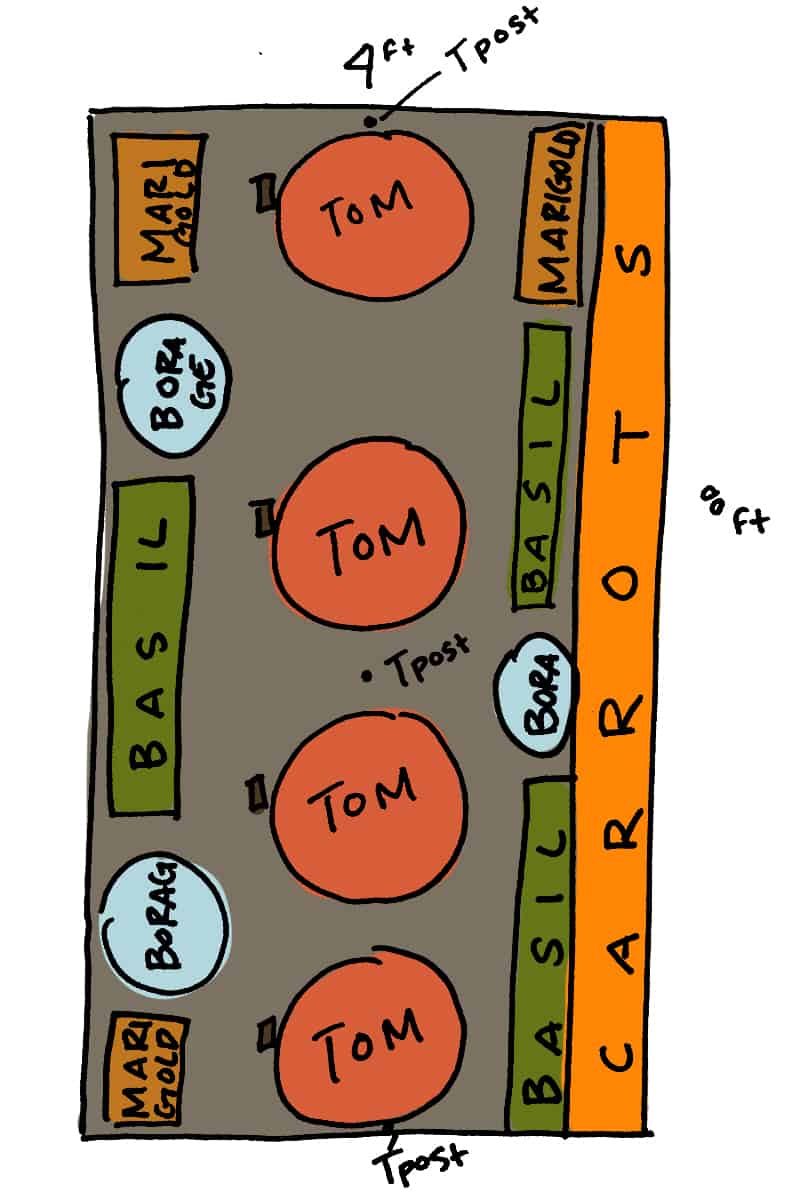
- Once plants are 18 inches – 24 inches: Stake the tomatoes using a wood or plastic pole that will hold the tomato, then use a tomato clip or use hemp or cotton twine to loosely attach the plant to the stake. Allow to grow and continue doing this.
- After 4 weeks of Growing: Place a T-post every 4-5 feet in the row, depending on the size of your bed for your tomatoes. Have the notches facing out in the same direction to use as support for your twine.
- Begin Your Weave: This method is called a Florida Weave. You can see how it works in the diagram below. You will do one weave every 8-10 inches. The plant grows throughout the entire growing season. Make them taunt in order to support branches and heavy fruit.
- Continue as plants grow: As the plants grow, you will continue to weave and tieing the plant to its stake.
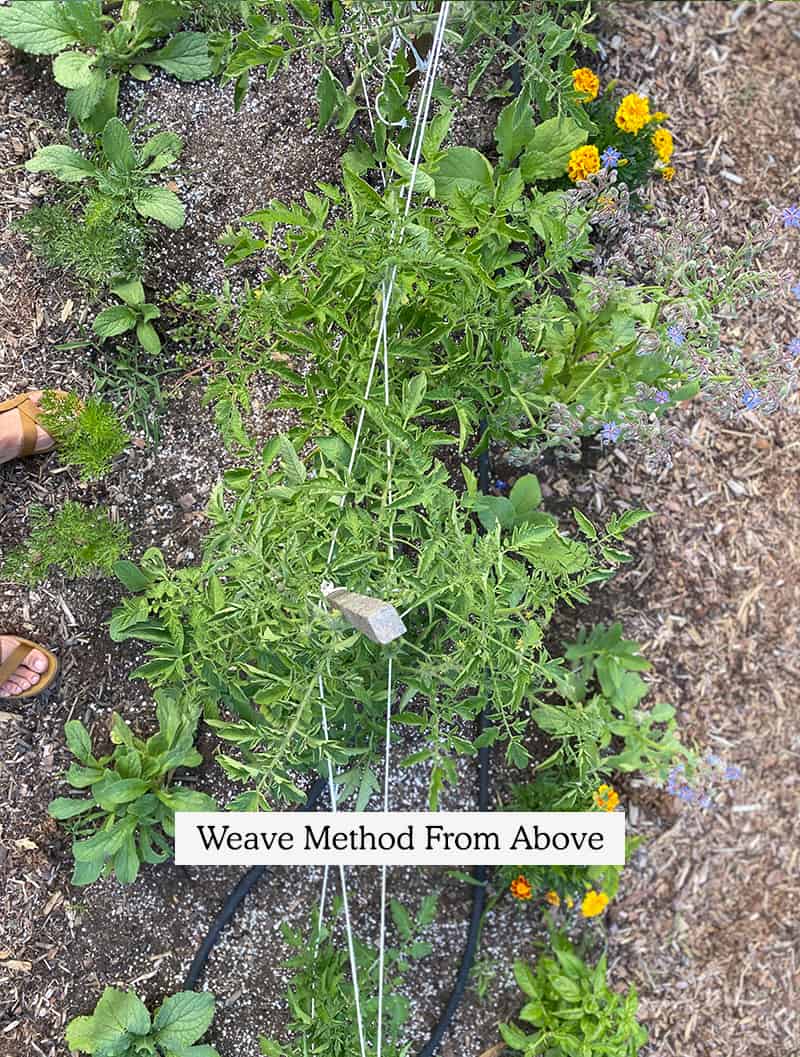
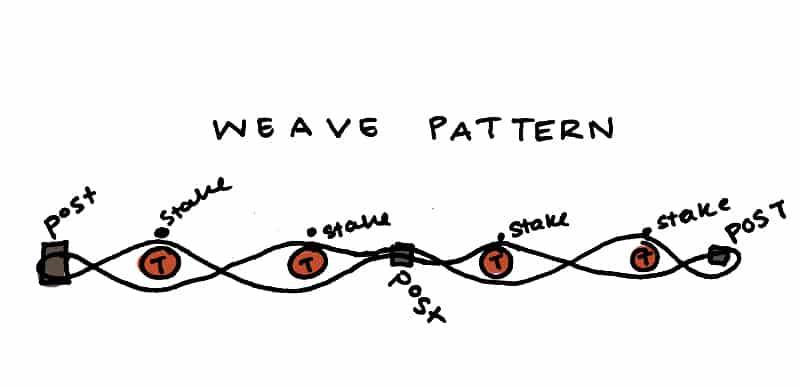
The Materials You Need to Support Tomatoes Without Tomato Cages:
This method requires such little material and many of which can be stored vertically next to the garden through the off-season. They take up a very small amount of space compared to fitting your tomato cages together in some odd place so you don’t run into the spikes in the winter months. Here are the materials you will need:
- Wood or Plastic Garden Stake – One per plant
- Metal T-post – 1 every 4-5 feet but at least 2 (think 2 every 3-4 plants)
- Hammer – For hammering in the wood Stakes
- Post driver – This is the best way to get those stakes into the ground.
- Natural Fiber Twine – A huge roll will be necessary. You can use a metal chord if you plan to keep this permanently in your garden
- Pruning Shears – To clean up your tomatoes as they grow
- Scissors to cut twine – These will only cut the twine.
If you built our DIY Garden Fence, you most likely have many of these materials from creating that as well.

DIY Tomato Cages – Other Alternatives
1. Trellises
Tomatoes can be grown on a trellis, which provides good support for the plants and their developing fruit. There are many forms of commercial or homemade ones available but generally, they consist of vertical stakes with some type of horizontal prop to keep them off ground level.
2. Stakes
The most common method of staking tomatoes is by using stakes set 2 to 3 feet apart. A single vine can be attached each time at 1 foot off the ground, with an additional 12-inch piece put down for every subsequent layer as it trains up its pole; this newer option uses metal spiral rods instead!
3. Stands and Tripods
Different types of tripods can be used to support one or several tomato plants.
4. Ladders and Fences
It’s easy to make your own tomato ladder, and it provides excellent support for growing plants. Plant the young ones at the base of each rung on either side (or in between), then train they’re stems up between two parallel fences that are 6 inches apart; use wire fencing materials if you want something more sturdy, like staked boards or bamboo supports instead!
What Do With Extra Tomato Cages:
I think the misconception with Tomato Cages is they are only for tomatoes, but the truth is they offer a lot of help in the garden with other plants that don’t grow as tall but still need support. Here are a few plants you can use your tomato cage for instead of Tomatoes:
- Eggplant
- Pole Beans
- Sugar Snap Peas
- Large flowers like sunflowers or Snapdragons
- Supporting large Cosmo bushes
- Tomatillos
They still serve wonderful purposes, but they are not great at supporting tomatoes. That is the truth, and this method above will be most helpful in a stressless Tomato experience in your garden this summer.
If you find this DIY tomato cages alternative, consider checking out these articles below –
- How To Prune Tomato Plants – Everything You Need To Know
- 8 Best Tomato Companion Plants – To Ward Off Pests
- How To Freeze Tomatoes Easily – Without Blanching
- Garden: Tomato Planting
- Easy To Make Tomato Salad Recipe
Get your daily dose of gardening inspiration and education by following the Fresh Exchange social media pages and podcasts. Follow us now and start growing!
Want to take your gardening skills to the next level? Join the Fresh Exchange community and gain access to our exclusive gardening courses that will teach you everything you need to know to create a thriving garden. Sign up today and start your journey toward creating the garden of your dreams!




